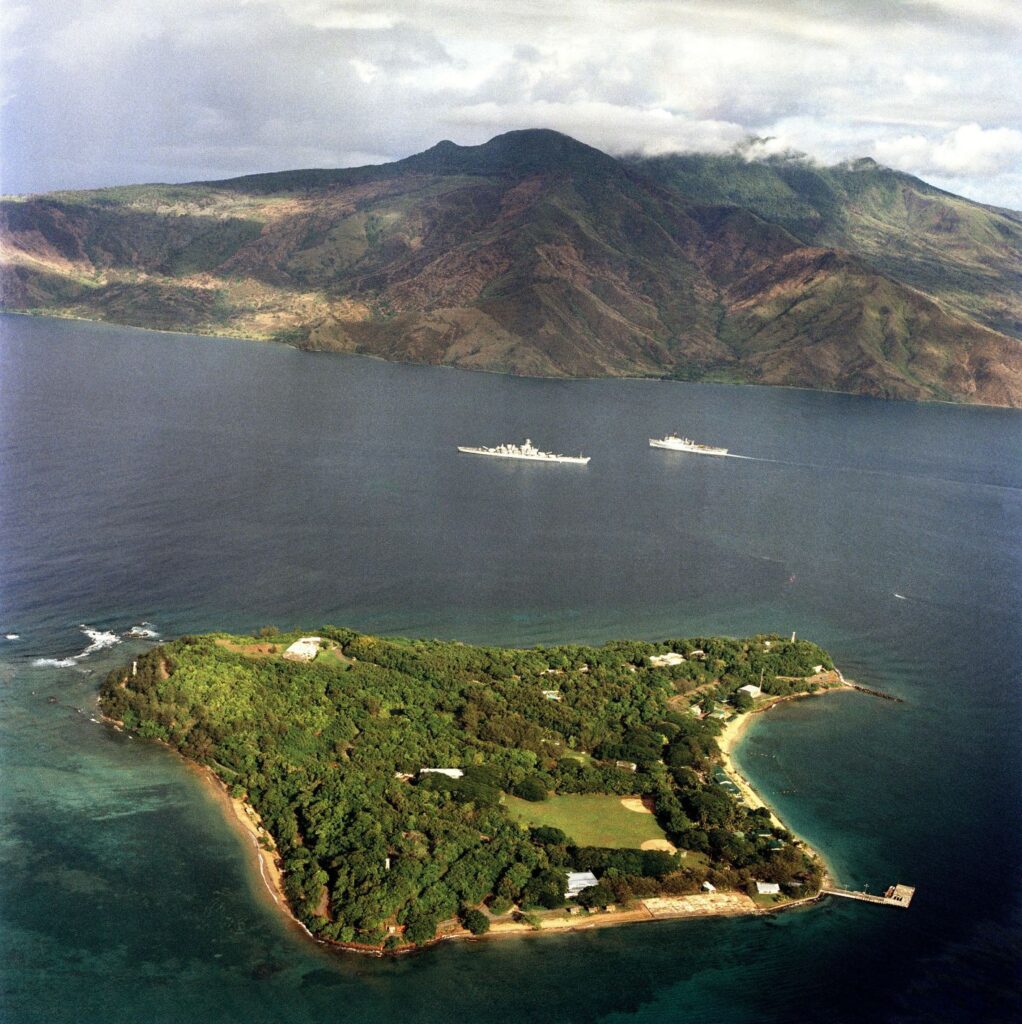
Zd869. This is a 1983-02-14 Grande Island picture from NARA via Wikipedia with Battleship New Jersey BB-62 and a LSD or LPD passing each other. Now that is a Navy picture, it makes a sailor like me, proud as heck; did diving work under that Battle wagon in Subic and served on two LSDs.
This picture can be downloaded in high resolution with this URL, click here:
——————————————–
In 1941 Grande Island was Fort Wint and the American/Philippine Command decided to evacuate to build a better defense of Luzon in Bataan and Manila Bay. But Grande Island, Fort Wint and Subic Bay did get touched by the war before the evacuation.
John Duresky is the researcher of the writing team of the new book “Relentless Hope: A True Story of War and Survival, by David L. Britt” and he sent most of these pictures, writings and the material to me. I have helped him out with some information and John Duresky is sharing almost all his finds with me. Thank you very much, John.
————————————————-
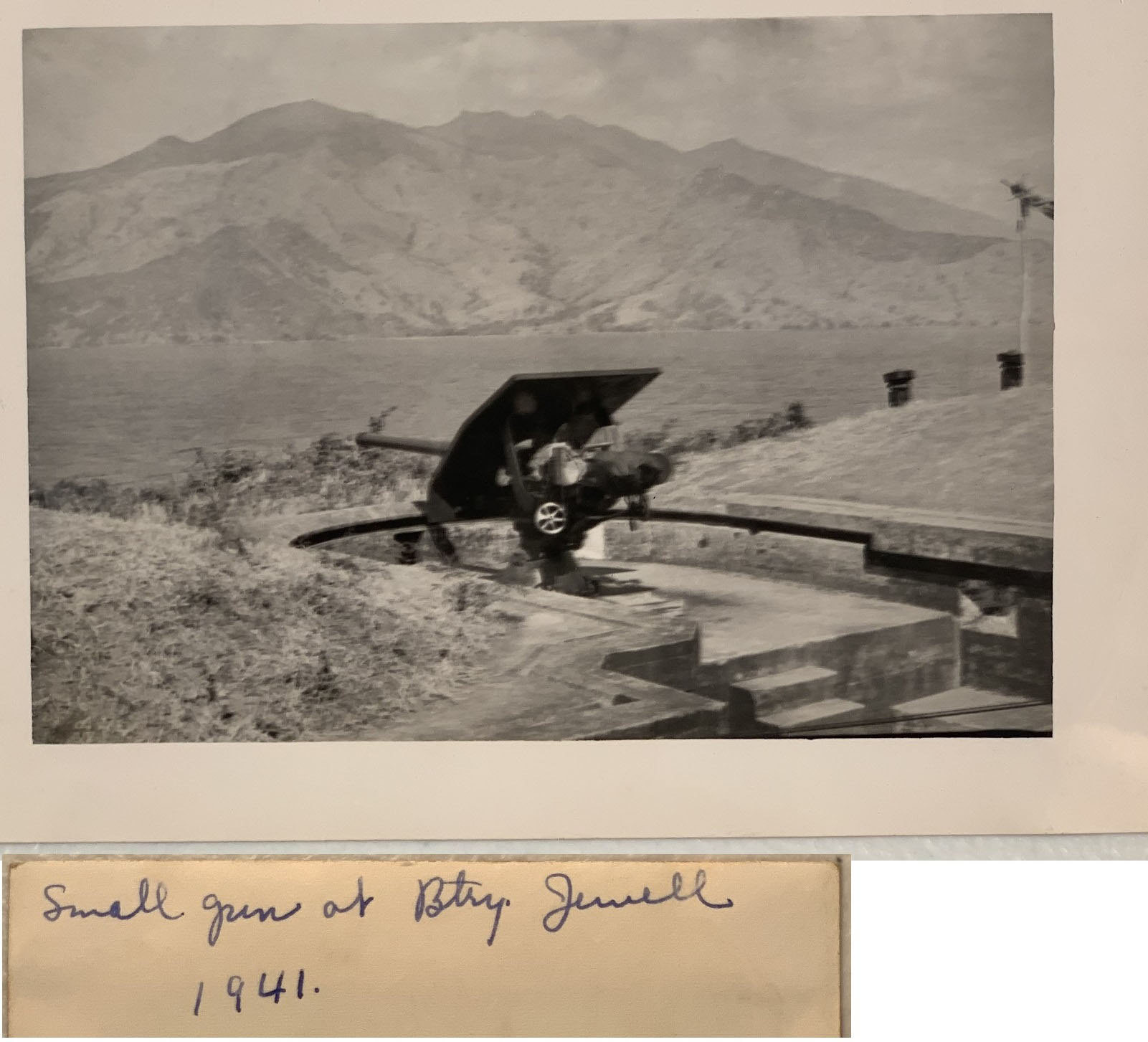
Zg430. This attached photo was taken in early 1941 by Chester or Grace Britt showing one of the four guns at Battery Jewell, and the other is photo taken by American forces after the fort was retaken in January, 1945 without firing a shot because the Japanese also wisely abandoned it. Battery Jewell holds the distinction of having the only artillery pieces to fire in combat on the island during WWII. Those unknown 30 Japanese soldiers are now among Japan’s hundreds of thousands of MIA from WWII.
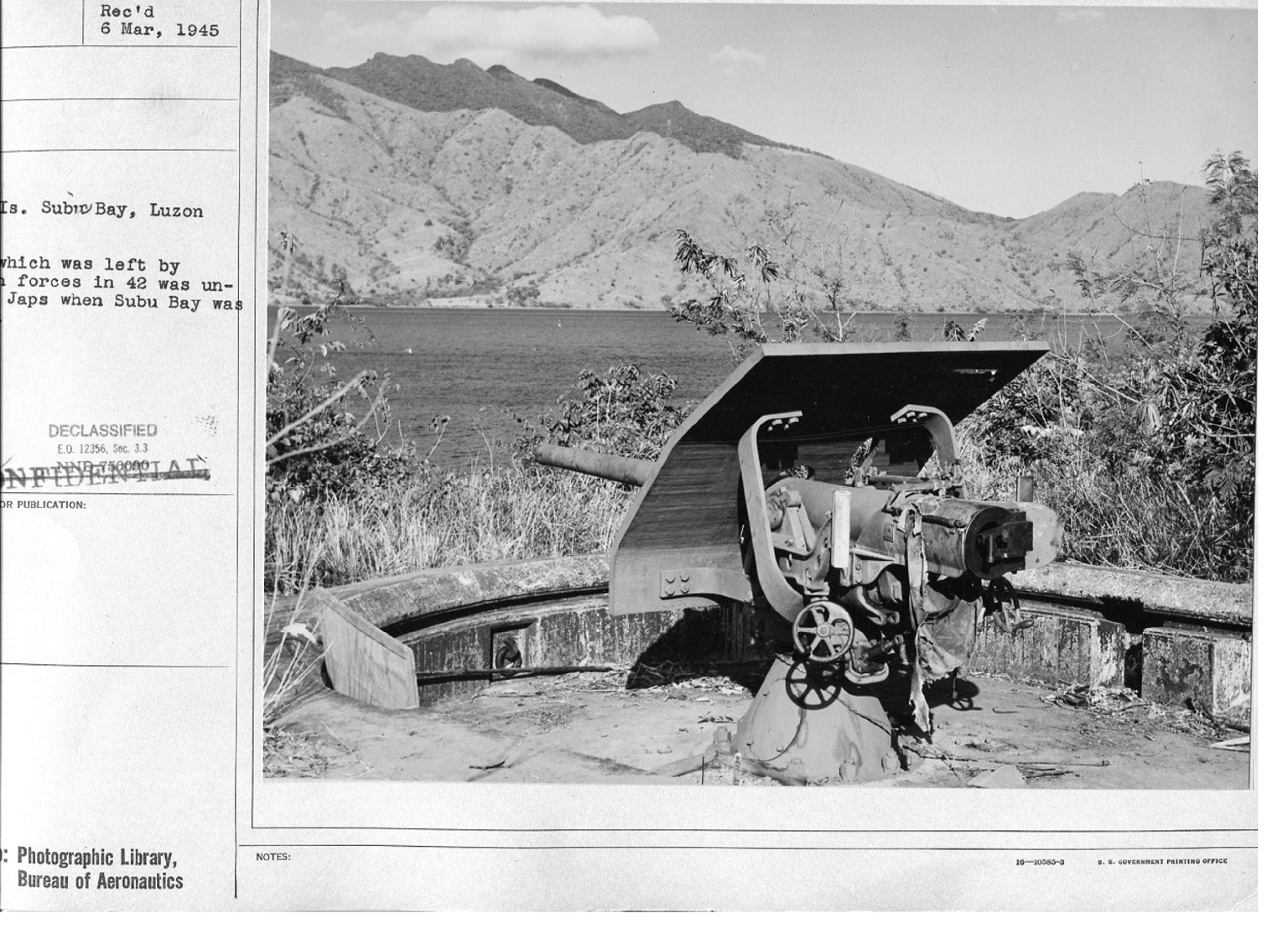
Zg431. This is the other photo of one of the four guns at Battery Jewell taken by American forces after the fort was retaken in January, 1945 without firing a shot because the Japanese also wisely abandoned it.
John Duresky writes:
Battery Jewell at Fort Wint on Grande Island in Subic Bay, Philippines, was actively involved in the war from December 8, 1941, to December 25, 1941. On December 25th Fort Wint was abandoned and all the men went generally to Bataan or Corregidor. The small island was indefensible had the Japanese assaulted it and the defenders would have been massacred had it not been abandoned.
Chester Britt in our book RELENTLESS HOPE – A True Story of War and Survival, by his son David Britt, went to Bataan from Fort Wint. After the fort was abandoned, its commander wrote the attached after action report. Among the details is the fact that on December 18, 1941, one or more of the four guns at Battery Jewell sank a small boat, most likely a barge (aka landing craft) holding about 30 Japanese soldiers south of Sueste Point, close to where the Oryoku Maru was later attacked by American planes on December 14, 1944.
The artillery at Battery Jewell were Model 1903 Rapid Fire (R.F.) 3-inch guns. From Wikipedia, click here: https://en.wikipedia.org/wiki/3-inch_gun_M1903 this gun battery of four gun emplacements would have been “….under the command of the battery commander. The battery commander is assisted by a battery executive and an assistant battery executive. These positions are filled by officers. Each gun in an emplacement is manned by a gun section consisting of a gun squad of 15 (war strength) enlisted menincluding one noncommissioned officer (NCO), the chief of section, and an ammunition squad of 9 (war strength) enlisted men, one noncommissioned officer, the chief of ammunition….” “….Each gun’s rate of fire was 12 rounds/minute (up to 30 rounds/minute maximum)….”
NOTE: On Fort Wint, all 3 officers would have been Americans and the 60 enlisted men and NCOs would have been Philippine Scouts and Philippine army men.
The attached photo was taken in early 1941 by Chester or Grace Britt showing one of the four guns at Battery Jewell, and the other is photo taken by American forces after the fort was retaken in January, 1945 without firing a shot because the Japanese also wisely abandoned it. Battery Jewell holds the distinction of having the only artillery pieces to fire in combat on the island during WWII. Those unknown 30 Japanese soldiers are now among Japan’s hundreds of thousands of MIA from WWII.
Attached is one grainy photo showing Grande Island being bombarded by the Americans in preparation for a landing in January 1945.
Yesterday, I visited Fort Casey in Washington State. In 1968, two of the 3 inch guns from Battery Jewell, and two 10 inch guns from Fort Wint were moved there. Attached are photos of the two guns from Battery Jewel. One has the end of the barrel missing. The other shows heavy shrapnel damage attached here, my assumption is that occurred during the bombardment. Maybe the bombing was successful enough to get the Japanese to leave and thereby save lives that would have been lost assaulting the island. Maybe someone will visit Fort Wint and be able to tie in damage on these guns to damage on one of the concrete emplacements to determine where this was located during the war.
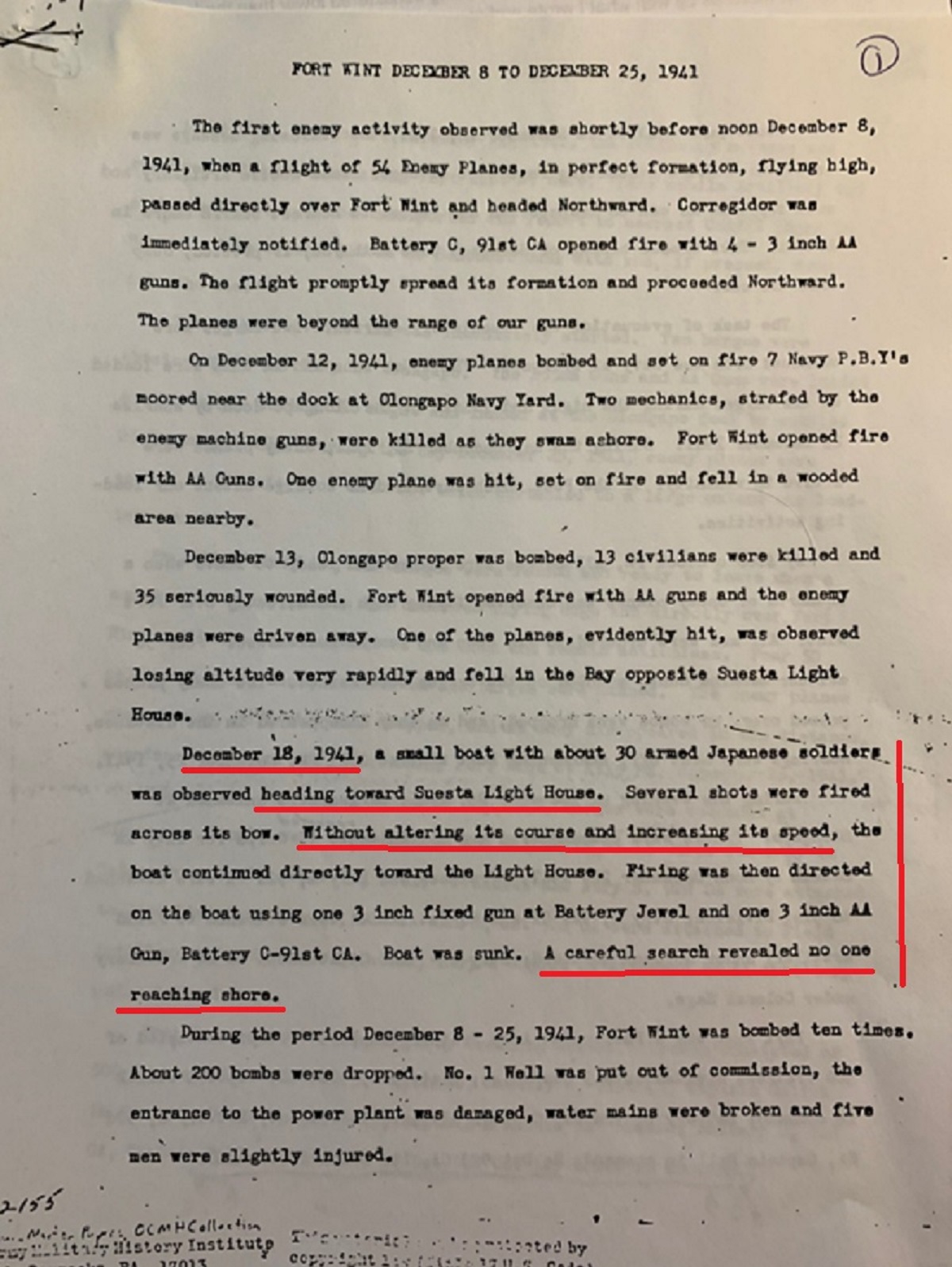
Zg432. Marked up Fort Wint battle report copy. After the fort was abandoned, its commander, Col Boudreau, wrote the above after action report. Among the details is the fact that on December 18, 1941, one or more of the four guns at Battery Jewell sank a small boat, most likely a barge (aka landing craft) holding about 30 Japanese soldiers south of Sueste Point, close to where the Oryoku Maru was later attacked by American planes on December 14, 1944.
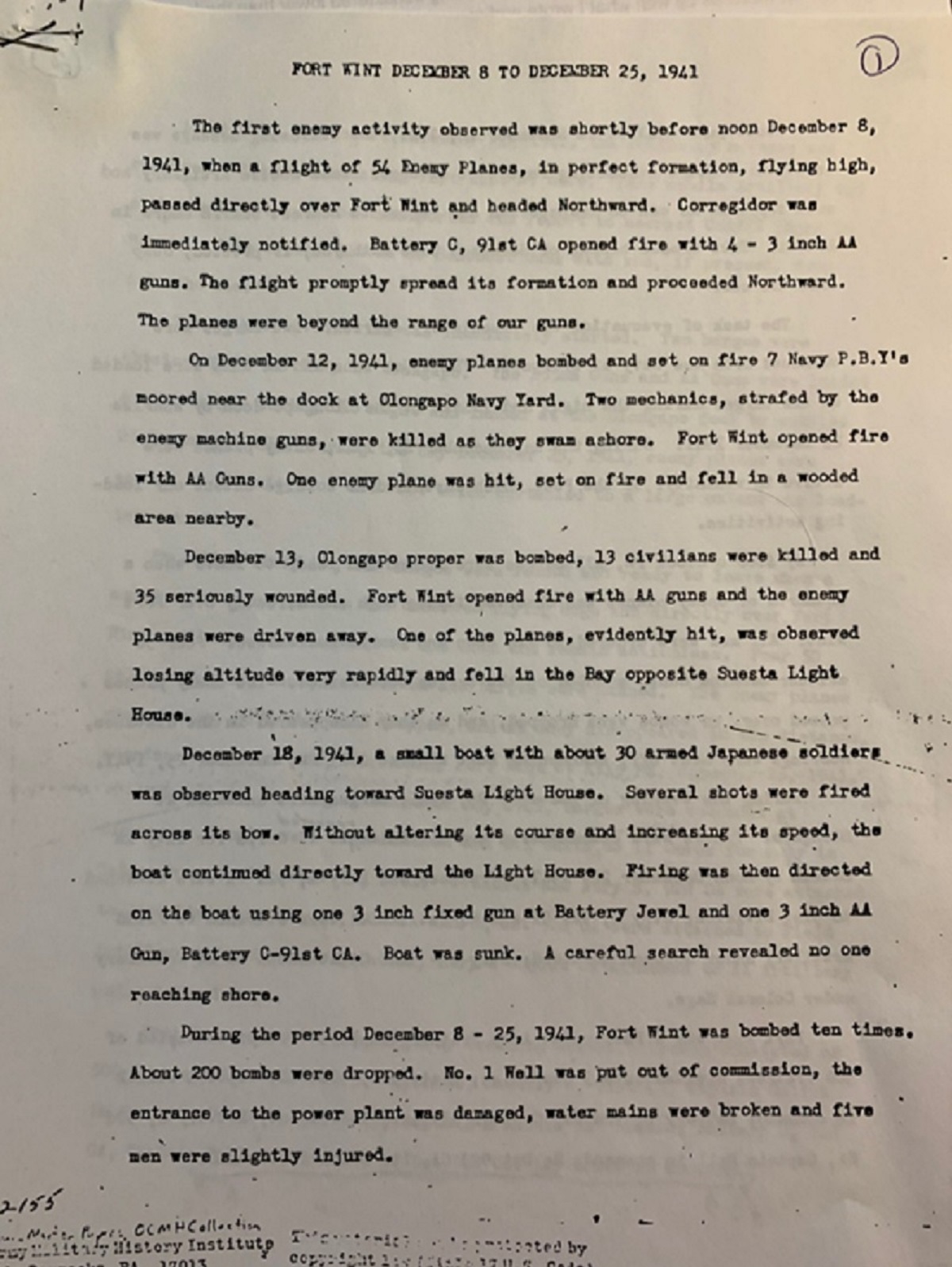
Zg433. Unmaked Fort Wint battle report copy. After the fort was abandoned, its commander, Col Boudreau, wrote the above after action report. Among the details is the fact that on December 18, 1941, one or more of the four guns at Battery Jewell sank a small boat, most likely a barge (aka landing craft) holding about 30 Japanese soldiers south of Sueste Point, close to where the Oryoku Maru was later attacked by American planes on December 14, 1944.

Zg434. This is a detailed map of Fort Wint on Grande Island in Subic Bay. It was produced a long time ago by the crew of a Navy Oiler, operating out the Subic Bay Naval Base, post war.
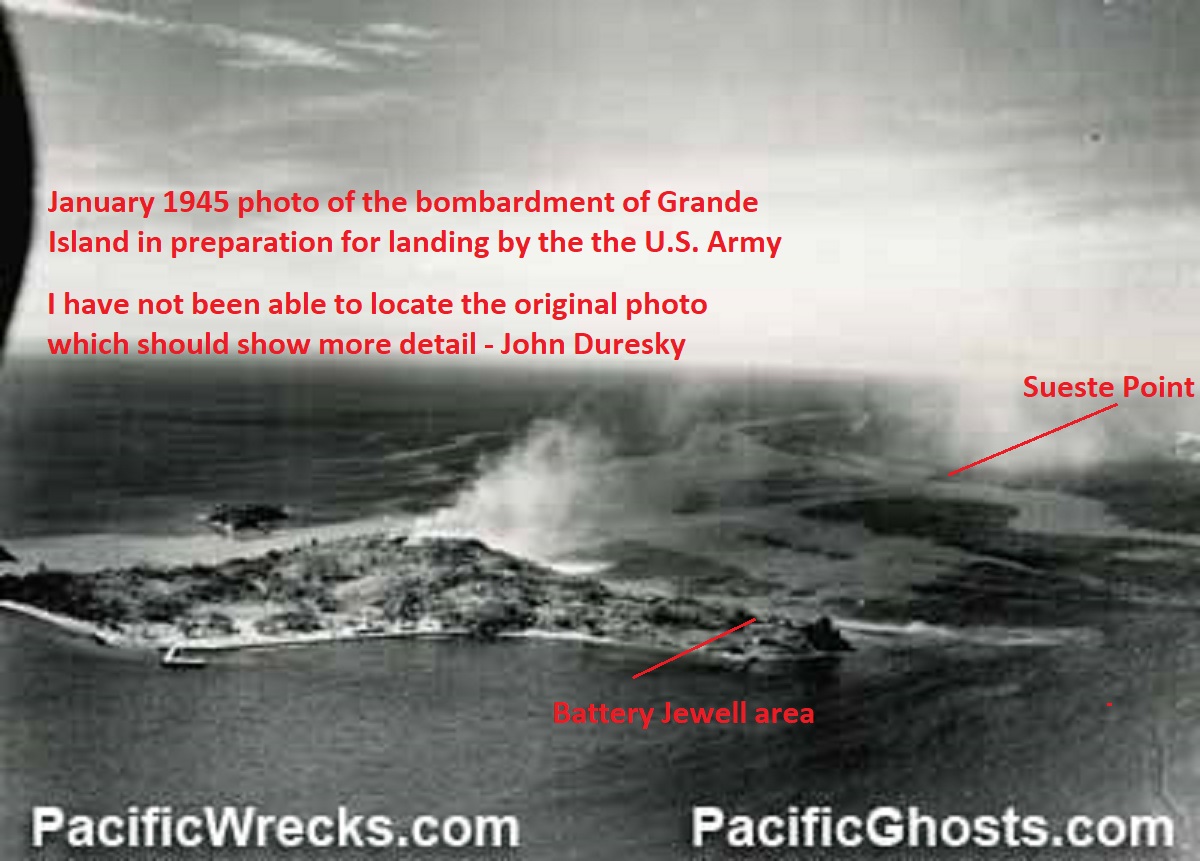
Zg434a. This is one grainy photo showing Grande Island being bombarded by the Americans in preparation for a landing in January 1945. The American forces reoccupied Fort Wint on Grande Island in Jan./Feb.1945 without firing a shot because the Japanese also wisely abandoned it.
————————————
I visited Fort Casey this year in Washington State. In 1968, two of the 3 inch guns from Battery Jewell, and two 10 inch guns from Fort Wint were moved there. Attached are photos of the two guns from Battery Jewel (7 images). One has the end of the barrel missing. The other shows heavy shrapnel damage attached here, my assumption is that occurred during the bombardment. Maybe the bombing was successful enough to get the Japanese to leave and thereby save lives that would have been lost assaulting the island. Maybe someone will visit Fort Wint and be able to tie in damage on these guns to damage on one of the concrete emplacements to determine where this was located during the war.
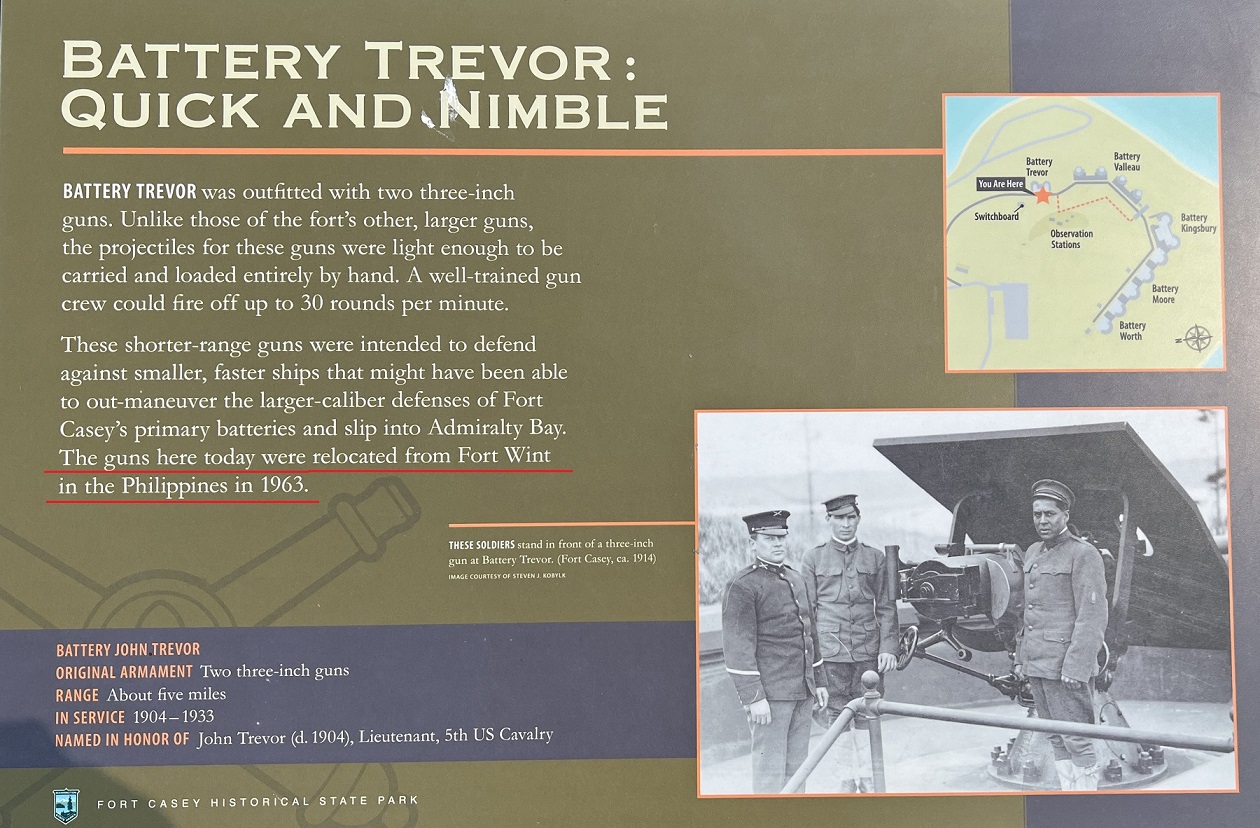
Zg435. This is Battery Trevor in Coastal Artillery Fort Casey at Washington State, the guns were scrapped after the war and in 1968 this former fort received two replacement 3 inch guns from the former Fort Wint in Subic Bay.
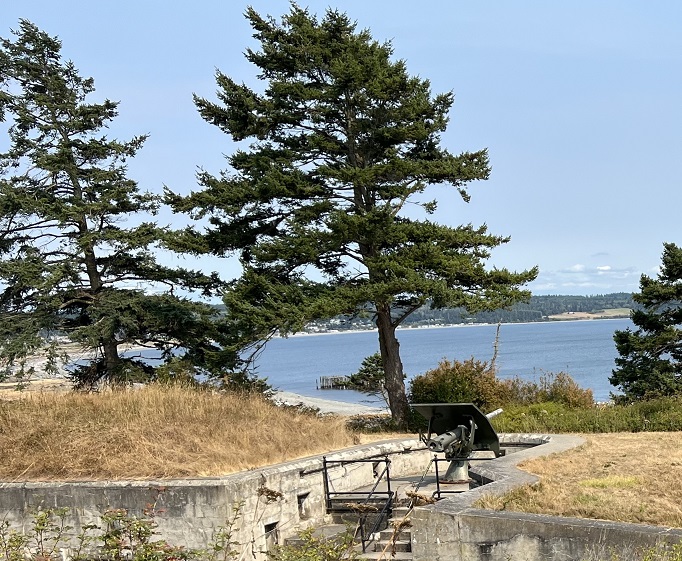
Zg436. This is one of the two 3 Inch guns, now at the former Fort Casey at Washington State, that were transferred from the former Fort Wint on Grande Island in Subic Bay. In 1968, two of the 3 inch guns from Battery Jewell, and two 10 inch guns from Fort Wint were moved here.
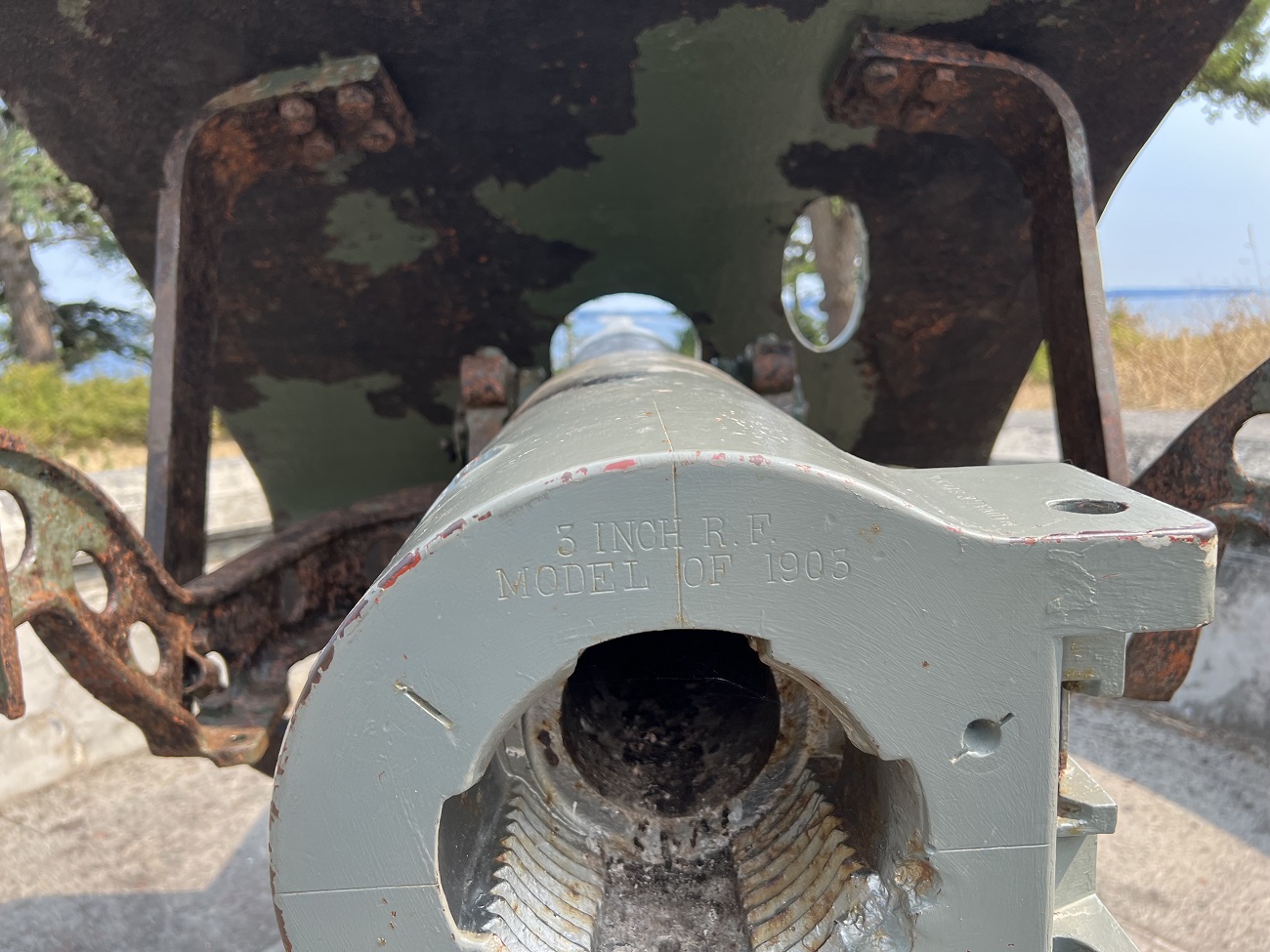
Zg437. This is one of the two 3 Inch guns, now at the former Fort Casey at Washington State, that were transferred from the former Fort Wint on Grande Island in Subic Bay. In 1968, two of the 3 inch guns from Battery Jewell, and two 10 inch guns from Fort Wint were moved here.
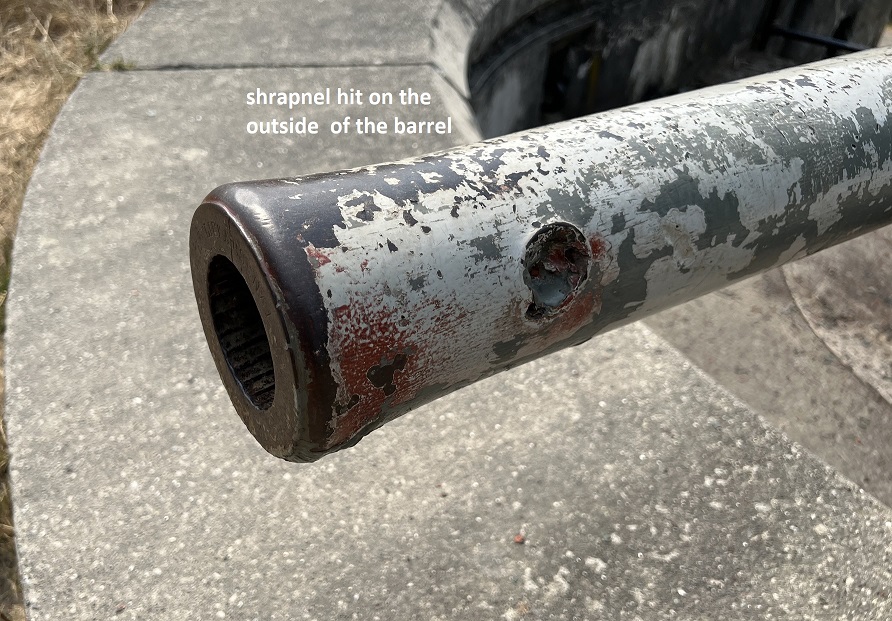
Zg438. This is one of the two 3 Inch guns, now at the former Fort Casey at Washington State, that were transferred from the former Fort Wint on Grande Island in Subic Bay. In 1968, two of the 3 inch guns from Battery Jewell, and two 10 inch guns from Fort Wint were moved here.

Zg439. This is one of the two 3 Inch guns, now at the former Fort Casey at Washington State, that were transferred from the former Fort Wint on Grande Island in Subic Bay. In 1968, two of the 3 inch guns from Battery Jewell, and two 10 inch guns from Fort Wint were moved here.
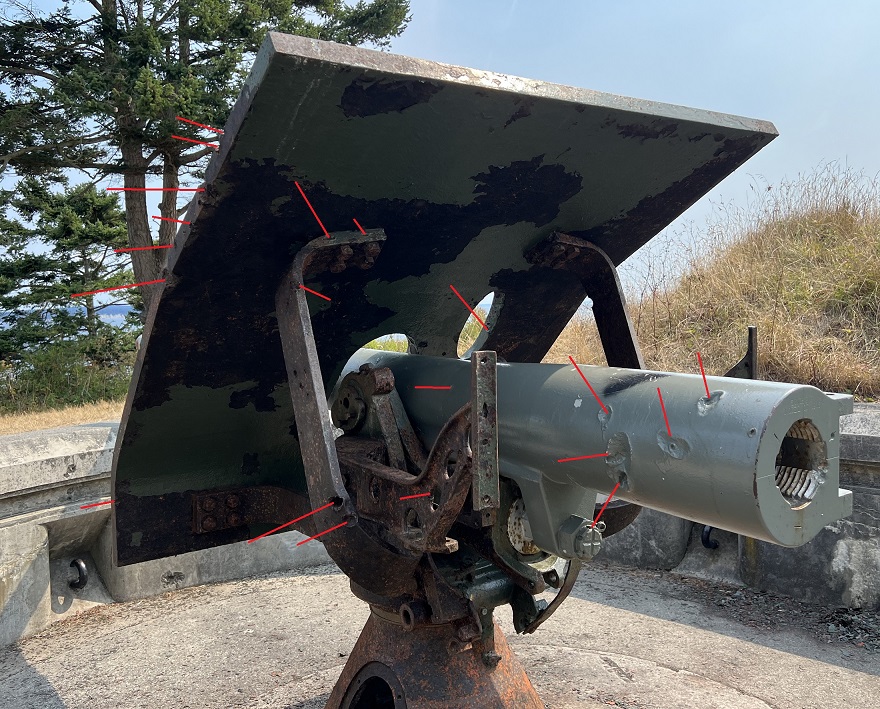
Zg440. This is one of the two 3 Inch guns, now at the former Fort Casey at Washington State, that were transferred from the former Fort Wint on Grande Island in Subic Bay. In 1968, two of the 3 inch guns from Battery Jewell, and two 10 inch guns from Fort Wint were moved here.
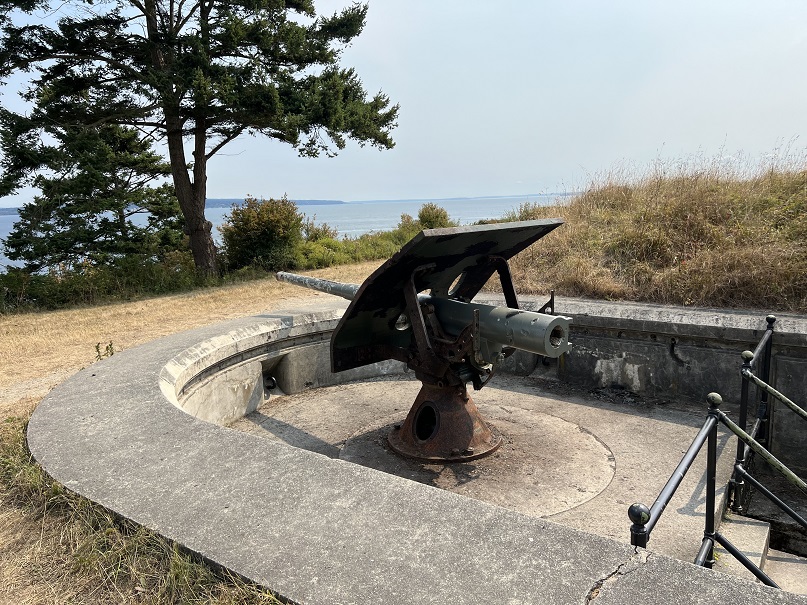
Zg441. This is one of the two 3 Inch guns, now at the former Fort Casey at Washington State, that were transferred from the former Fort Wint on Grande Island in Subic Bay. In 1968, two of the 3 inch guns from Battery Jewell, and two 10 inch guns from Fort Wint were moved here.
War in Subic Bay 1941, picture additions
Note from Karl: John Duresky is the researcher of the writing team of the new book “Relentless Hope: A True Story of War and Survival, by David L. Britt” and he sent these words and these 3 images: It is in response to a chat about Ft. Wint, the Oryoku Maru attacked by US Navy planes at Subic Bay and one shot down and others in other attacks. The chat is also about Japanese air attacks in this area.
John Duresky writes:
No problem, thanks for resending. Copying the group. All you write sounds good.
I am imagining the barge coming off a larger mother ship around the southern tip of Redondo Peninsula, so the mother ship is out of sight of the big guns on Fort Wint. Then the barge comes around the tip and hugs the east coast of the Redondo Peninsula until it is sighted and then sunk somewhere south of Sueste Point. It would have to been in line of sight from Battery Jewell when it was hit, so not inside any inlet along the coast, and it should now consist of a pile of Japanese weapons, helmets, etc. This book I have that Paul Whitman put into flip book format shows the Japanese barges then in use which might be helpful for identification if any remnants of the actual barge are found, click here:
On page 42 of the flip book I even managed to snap up the attached Wirephoto found on that page showing a mother ship and the barges on and around it.
The Japanese plane is trickier, but I assume it was coming from the Olongapo area when it was hit. It’s unfortunate that Col Boudreau didn’t give any compass headings or distances, but on the plus side that is probably why the barge and plane haven’t been found yet.
On a side note, attached is a photo of the Boudreau’s and one with Grace Britt taken on the north side of Fort Wint around March 1941. Both were heavily scratched, and I’ve touched them up the best I could.
John
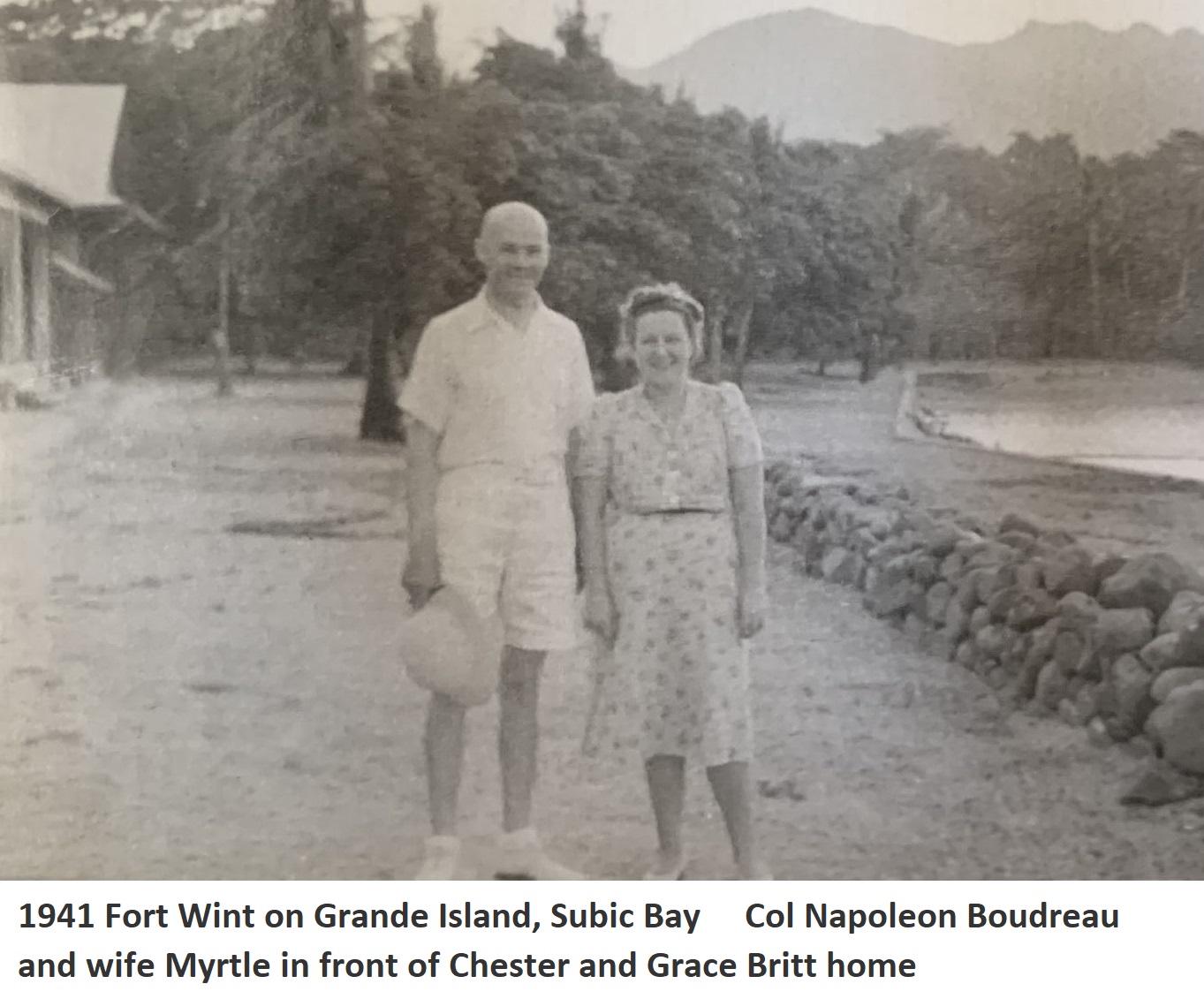
Zg442. 1941 Fort Wint, Col. and Mrs Napoleon Boudreau in front of Lt. Britt’s home. After being order4ed to abandon Fort Wint, the Colonel became the Commanding Officer of Fort Frank on Carabao Island in Manila Bay.
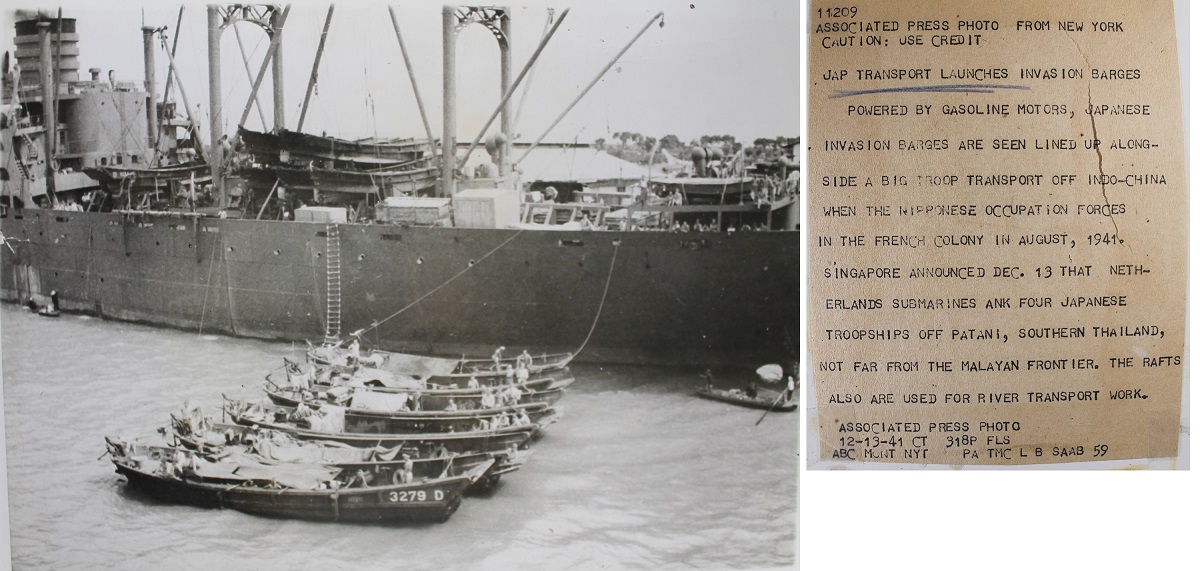
Zg443. 1941-12-13 a Japanese transport and barges in Indochina WIREPHOTO.
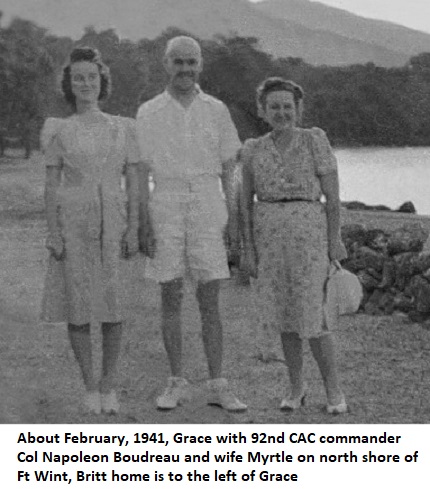
Zg444. About Feb. 1941 at Fort Wint, are Grace, Col. and Mrs Napoleon Boudreau in front of Lt. Britt’s home.